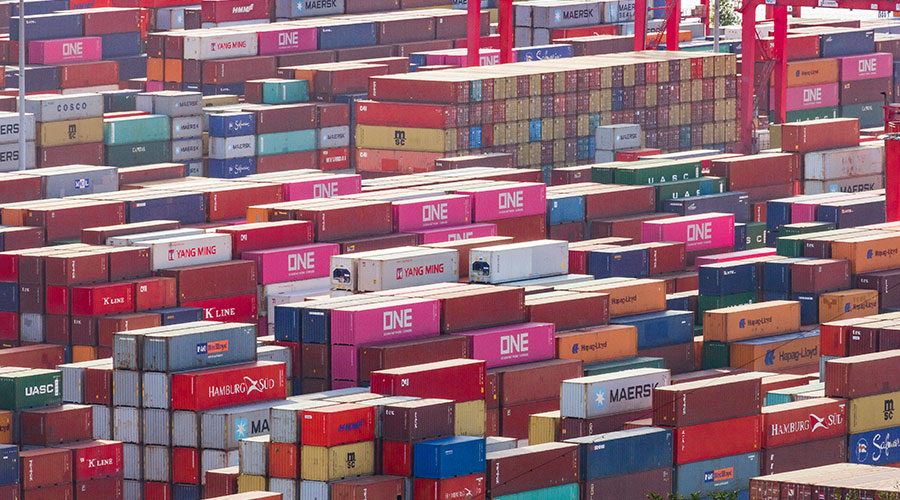

U.S. West freight continued to fall, Trump tariffs did not cause freight prices to rise?
There has not yet been a rumoured rush to pull goods triggered by the early effect of tariffs, and freight rates on the US West Line continued to fall by 8.61%, a trend that also dragged down the Shanghai Export Freight Index (SCFI), causing it to fall another 4.08% to 2,160.08 points on the 22nd. At the same time, the Mediterranean line, the European line and the United States East line also showed a small decline, falling 0.29%, 1.23% and 1.28% respectively. Although the South American line (Santos shipping point) had risen earlier, it also retreated by 4.64% this time.
Freight forwarder practitioners pointed out that the current volume of goods in the United States is relatively stable. Despite the rhetoric of the so-called "Trump 2.0" policy proposing substantial tariff increases, due to the lack of specific policies and timetables, even if some customers pull goods in advance, it is not enough to have a significant impact on supply and demand. In addition, in advance of the shipment also need to consider the importer's warehousing costs.
One of the main reasons for the decline is oversupply, which has dropped more than $1,000 in the past three weeks.
It is understood that the Marine industry giant MSC will cut prices again in the United States next week, and the price will fall below the 2 word. In order to stabilize market share and avoid customer loss, other shipping companies are expected to follow suit with price cuts.
In contrast, freight rates on European lines have remained stable. Freight forwarders said that the loading rate of ships has been good recently, and shipping companies have also used technical cabin control to stabilize prices. At the critical moment when the new contract is signed next year, major shipping companies have notified the price increase plan on December 1, and the price of each 40-foot container will rise to about $6,000, an increase of about $1,500 to $2,000. They are trying to prop up the price of the new contract by raising the spot price, but it remains to be seen how much and whether the increase will be successful.
According to the quotation of SCFI this week, the freight rate of Shanghai to Europe line per 20 feet container is 2,481 US dollars, down 31 US dollars, the weekly decline is 1.23%; The freight rate per 20-foot container to the Mediterranean line was $3,071, down $9, for a weekly decline of 0.29%; The freight rate per 40 feet container to the west of the United States is 3,821 US dollars, down 360 US dollars, a weekly decline of 8.61%; The freight rate per 40-foot container to the United States East was $4,997, down $65, for a weekly decline of 1.28%.

Freight forwarder practitioners pointed out that the current volume of goods in the United States is relatively stable. Despite the rhetoric of the so-called "Trump 2.0" policy proposing substantial tariff increases, due to the lack of specific policies and timetables, even if some customers pull goods in advance, it is not enough to have a significant impact on supply and demand. In addition, in advance of the shipment also need to consider the importer's warehousing costs.
One of the main reasons for the decline is oversupply, which has dropped more than $1,000 in the past three weeks.
It is understood that the Marine industry giant MSC will cut prices again in the United States next week, and the price will fall below the 2 word. In order to stabilize market share and avoid customer loss, other shipping companies are expected to follow suit with price cuts.
In contrast, freight rates on European lines have remained stable. Freight forwarders said that the loading rate of ships has been good recently, and shipping companies have also used technical cabin control to stabilize prices. At the critical moment when the new contract is signed next year, major shipping companies have notified the price increase plan on December 1, and the price of each 40-foot container will rise to about $6,000, an increase of about $1,500 to $2,000. They are trying to prop up the price of the new contract by raising the spot price, but it remains to be seen how much and whether the increase will be successful.
According to the quotation of SCFI this week, the freight rate of Shanghai to Europe line per 20 feet container is 2,481 US dollars, down 31 US dollars, the weekly decline is 1.23%; The freight rate per 20-foot container to the Mediterranean line was $3,071, down $9, for a weekly decline of 0.29%; The freight rate per 40 feet container to the west of the United States is 3,821 US dollars, down 360 US dollars, a weekly decline of 8.61%; The freight rate per 40-foot container to the United States East was $4,997, down $65, for a weekly decline of 1.28%.





